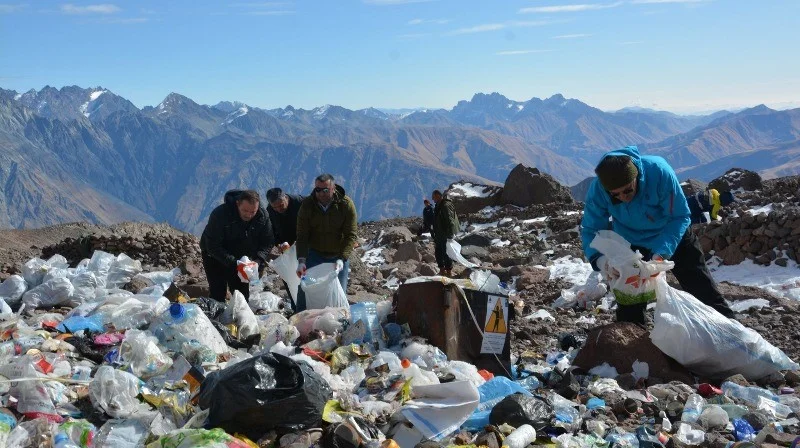Why Throwing Household Waste into Nature Harms Us All
- Nov-2025, 12:28
- 0 Comments
- 8 Views

It doesn't matter if you are an active hiker or a picnic lover, if you have ever been out in nature, you have most likely come across the "beauty of nature" left by your predecessor: empty and crushed water bottles, cigarette butts, or torn polyethylene bags. We all know that such reckless behavior causes serious harm to nature (not to mention the unaesthetic and unhygienic nature of garbage dumped in nature). But few people know exactly how. In this short article, you will read about the consequences of throwing garbage in nature.
First of all, we need to clarify what littering means. Throwing coffee cups, aluminum cans, cigarette butts, expired chewing gum, or other similar waste on the ground or throwing it out of your car is littering. The latter harms animals and plants, which ultimately affects us – humans.

Photo: Ministry of Environmental Protection and Agriculture of Georgia
Location: The path leading to Mkinvartsveri and the area surrounding the weather station (3,653 m above sea level)
Oxygen
Did you know that about 70-80% of the planet's oxygen is produced by the water?
Of the more than 6.9 billion tons of plastic waste on Earth, about 6.3 billion tons never even make it to the landfill - they are thrown directly into forests or oceans by humans. This garbage, left in nature, eventually breaks down in water and poses a threat to the microorganisms that make the most contribution to oxygen production.
Drinking water
Not to mention the pollution of the air that is vital to human life, drinking water is also becoming unfit for human consumption. Microplastic particles poison drinking water and enter the human body. The so-called persistent, bioaccumulative and toxic (PBT) chemicals are particularly dangerous. Waste dumped in the mountains, which contain the above-mentioned substances, poison springs and rivers, which are of vital importance to the population.
Animals and birds
Habitat structure changes are caused by the accumulation of organic and inorganic waste in places such as the shores and bottoms of seas, oceans, rivers, or springs. Waste dumped on roads/in forests/mountains is washed away by rainwater and chemicals reach groundwater. They change the level of light and oxygen and the chemical composition of the water, which ultimately has catastrophic consequences for organisms that feed on this water.
Chemicals released from plastic waste can destroy microorganisms that plants and small aquatic insects feed on. This has a direct impact on fish and other underwater creatures. Ultimately, their disappearance will destroy the animals and birds that feed on these organisms. The processes taking place in nature are more interconnected than we might think. Therefore, it is necessary to understand how much damage each bottle or cigarette butt we throw away can cause.
What can we do to avoid delaying nature?
Carry a reusable cup – you will avoid a lot of unwanted waste in the form of single-use polyethylene or paper cups. A metal cup is preferable – it is not harmful to health (a plastic cup releases toxic substances when reacting with hot liquid and sometimes causes serious harm to health) and has good durability (a paper cup in most cases rots and becomes unusable after the first use).
Carry a reusable water bottle – the largest share of household waste in the environment comes from plastic bottles. Georgia has sufficient water supplies. There are springs on almost every hiking route where we can fill up with water. For this, having a reusable bottle with us and knowing the water points is enough.
Take back what you brought – if you still want to use disposable items, or if you are not an active hiker and do not want to buy special utensils for a one-day picnic, then you should understand this principle: what you bring with you in a backpack, you should take back again. When you empty your water bottle, do not throw it into nature (and proudly boast that you are keeping the rangers or forest cleaners employed with your bad habit), but take it back (ideally, put it in a trash can somewhere on your way home). The same principle applies to disposable food packaging, polyethylene bags, cigarette butts, or other toxic waste.
“What’s this one doing?” – Some people’s psychology works in such a strange way: if someone else has thrown away their trash, they can do the same: adding one more bag to several hundred bags won’t change much. Is that right? No, no, no! Such careless and thoughtless behavior has filled the glacier (and not only) with thousands of kilograms of waste. Bringing them down from such a complex terrain is difficult and associated with great costs (a helicopter was needed to bring hundreds of bags of waste down from the glacier). Therefore, let’s try not to throw away trash even when the environment is already full of waste. On the contrary, let’s try and, like some exemplary hikers, pick up even the waste left by others on the trail.